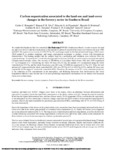Use este identificador para citar ou linkar para este item:
http://www.alice.cnptia.embrapa.br/alice/handle/doc/1055659Registro completo de metadados
| Campo DC | Valor | Idioma |
|---|---|---|
| dc.contributor.author | RONQUIM, C. C. | pt_BR |
| dc.contributor.author | SILVA, R. F. B. | pt_BR |
| dc.contributor.author | FIGUEIREDO, E. B. de | pt_BR |
| dc.contributor.author | BORDONA, R. O. | pt_BR |
| dc.date.accessioned | 2016-10-31T11:11:11Z | pt_BR |
| dc.date.available | 2016-10-31T11:11:11Z | pt_BR |
| dc.date.created | 2016-10-31 | pt_BR |
| dc.date.issued | 2016 | pt_BR |
| dc.identifier.citation | Proceedings of SPIE - International Society for Optical Engineering, v. 9998, p. 99981T-1- 99981T-14, 2016. | pt_BR |
| dc.identifier.uri | http://www.alice.cnptia.embrapa.br/alice/handle/doc/1055659 | pt_BR |
| dc.description | We studied the Paraíba do Sul river watershed , São Paulo state (PSWSP), Southeastern Brazil, in order to assess the land use and cover (LULC) and their implication s to the amount of carbon (C) stored in the forest cover between the years 1985 and 2015. Th e region covers a n area of 1,395,975 ha . We used images made by the Operational Land Imager (OLI) sensor (OLI/Landsat - 8) to produce mappings , and image segmentation techniques to produce vectors with homogeneous characteristics. The training samples and the samples used for classification and validation were collected from the segmented image. To quantify the C stocked in aboveground live biomass (AGLB) , we used an indirect method and applied literature - based reference values. The recovery of 205,690 ha of a secondary Native Forest (NF) after 1985 sequestered 9.7 Tg (Teragram) of C . Considering the whole NF area (455,232 ha), the amount of C accumulated al ong the whole watershed was 3 5 .5 Tg , and the whole Eucalyptus crop (EU) area (113,600 ha) sequester ed 4. 4 Tg of C. Thus, the total amount of C sequestered in the whole watershed (NF + EU) was 3 9 . 9 Tg of C or 1 45 . 6 Tg of CO 2 , and the NF areas were responsible for the large st C stock at the watershed (8 9 %). Therefore , the increase of the NF cover contribut es positively to the reduction of CO 2 concentration in the atmosphere, and Reducing Emissions from Deforestation and Forest Degradation (REDD + ) may become one of the most promising compensation mechanisms for the farmers who increased forest cover at their farms. | pt_BR |
| dc.language.iso | eng | eng |
| dc.rights | openAccess | eng |
| dc.subject | Forestry dynamics | pt_BR |
| dc.subject | Native forest | pt_BR |
| dc.subject | Paraíba do Sul River watershed | pt_BR |
| dc.subject | Dinâmica florestal | pt_BR |
| dc.subject | Rio Paraíba do Sul | pt_BR |
| dc.title | Carbon sequestration associated to the land-use and land-cover changes in the forestry sector in Southern Brazil. | pt_BR |
| dc.type | Artigo de periódico | pt_BR |
| dc.date.updated | 2017-05-19T11:11:11Z | pt_BR |
| dc.subject.thesagro | Floresta Nativa | pt_BR |
| dc.subject.thesagro | Sensoriamento Remoto | pt_BR |
| dc.subject.nalthesaurus | Eucalyptus | pt_BR |
| dc.subject.nalthesaurus | remote sensing | pt_BR |
| riaa.ainfo.id | 1055659 | pt_BR |
| riaa.ainfo.lastupdate | 2017-05-19 | pt_BR |
| dc.contributor.institution | CARLOS CESAR RONQUIM, CNPM; Ramon F. B. Silva, Unicamp; Eduardo B. de Figueiredo, Unesp, Jaboticabal; Ricardo O. Bordona, Brazilian Bioethanol Science and Technology Laboratory, Campinas. | pt_BR |
| Aparece nas coleções: | Artigo em periódico indexado (CNPM)  | |
Arquivos associados a este item:
| Arquivo | Descrição | Tamanho | Formato | |
|---|---|---|---|---|
| PaperCarbonoRonquimSPIE16.pdf | 810,67 kB | Adobe PDF |  Visualizar/Abrir |









